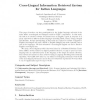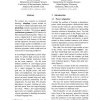136 search results - page 27 / 28 » Tailoring Word Alignments to Syntactic Machine Translation |
TSD
2007
Springer
13 years 11 months ago
2007
Springer
The world wide web is a natural setting for cross-lingual information retrieval. The European Union is a typical example of a multilingual scenario, where multiple users have to de...
CLEF
2007
Springer
13 years 11 months ago
2007
Springer
This paper describes our first participation in the Indian language sub-task of the main Adhoc monolingual and bilingual track in CLEF1 competition. In this track, the task is to...
EMNLP
2009
13 years 2 months ago
2009
We connect two scenarios in structured learning: adapting a parser trained on one corpus to another annotation style, and projecting syntactic annotations from one language to ano...
ACL
2009
13 years 2 months ago
2009
Mining bilingual data (including bilingual sentences and terms1 ) from the Web can benefit many NLP applications, such as machine translation and cross language information retrie...
COLING
2002
13 years 4 months ago
2002
Information extraction (IE) systems are costly to build because they require development texts, parsing tools, and specialized dictionaries for each application domain and each na...


